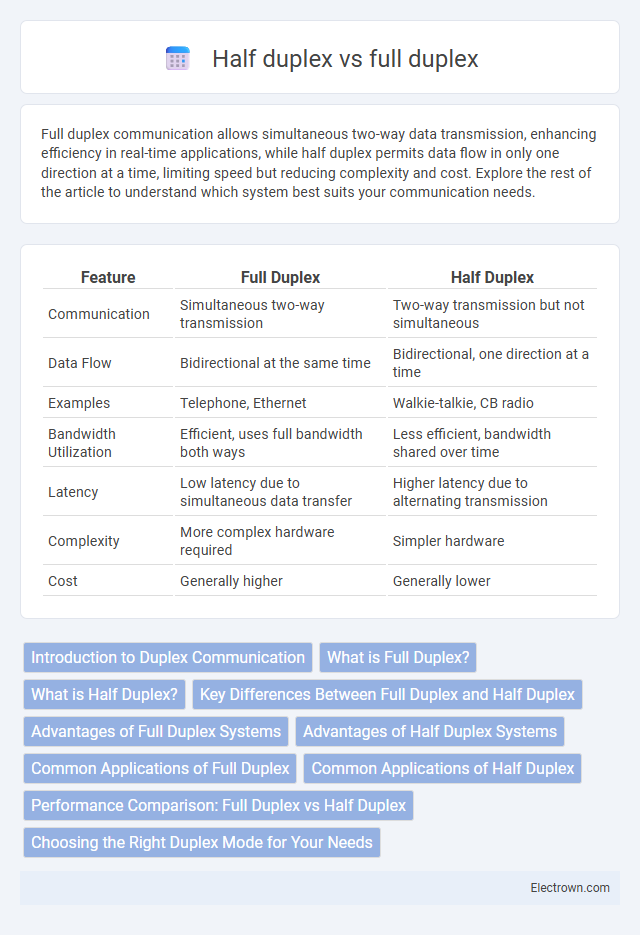Full duplex communication allows simultaneous two-way data transmission, enhancing efficiency in real-time applications, while half duplex permits data flow in only one direction at a time, limiting speed but reducing complexity and cost. Explore the rest of the article to understand which system best suits your communication needs.
Table of Comparison
| Feature | Full Duplex | Half Duplex |
|---|---|---|
| Communication | Simultaneous two-way transmission | Two-way transmission but not simultaneous |
| Data Flow | Bidirectional at the same time | Bidirectional, one direction at a time |
| Examples | Telephone, Ethernet | Walkie-talkie, CB radio |
| Bandwidth Utilization | Efficient, uses full bandwidth both ways | Less efficient, bandwidth shared over time |
| Latency | Low latency due to simultaneous data transfer | Higher latency due to alternating transmission |
| Complexity | More complex hardware required | Simpler hardware |
| Cost | Generally higher | Generally lower |
Introduction to Duplex Communication
Duplex communication refers to the method by which data transmission occurs between two devices, with full duplex allowing simultaneous two-way data flow and half duplex enabling data transfer in only one direction at a time. Full duplex systems, such as modern telephone networks, improve communication efficiency by allowing continuous, bidirectional exchange. Your choice between full duplex and half duplex depends on bandwidth requirements and the need for real-time interaction.
What is Full Duplex?
Full duplex communication allows simultaneous two-way data transmission between devices, enabling faster and more efficient information exchange. Unlike half duplex, where data flows in only one direction at a time, full duplex systems use separate channels or frequencies for sending and receiving signals concurrently. Your network performance benefits significantly from full duplex by reducing latency and enhancing overall connectivity.
What is Half Duplex?
Half duplex is a communication method where data transmission occurs in both directions, but not simultaneously, allowing either sending or receiving at one time. This mode is commonly used in walkie-talkies and traditional Ethernet networks, where devices take turns to communicate. Understanding half duplex helps you optimize network configurations when simultaneous two-way communication is unnecessary or bandwidth is limited.
Key Differences Between Full Duplex and Half Duplex
Full duplex communication allows simultaneous two-way data transmission, enabling devices to send and receive information at the same time, which increases efficiency in networks. Half duplex supports two-way communication but only in one direction at a time, requiring devices to alternate between sending and receiving, which can cause delays. Key differences include bandwidth utilization, with full duplex doubling potential throughput compared to half duplex, and reduced collision risk in full duplex systems due to simultaneous transmission capabilities.
Advantages of Full Duplex Systems
Full duplex systems enable simultaneous two-way communication, significantly increasing data transmission efficiency and reducing latency compared to half duplex systems. This continuous bidirectional flow enhances real-time applications such as video calls and online gaming by providing smoother and more responsive interactions. Improved channel utilization in full duplex networks also leads to higher overall bandwidth and better spectral efficiency.
Advantages of Half Duplex Systems
Half duplex systems offer cost-effective communication by utilizing a single communication channel for both transmitting and receiving signals, reducing hardware requirements. They enhance data security by limiting simultaneous transmission, which minimizes the risk of collisions and data interference. This simplicity supports efficient use in environments like walkie-talkies and industrial networks where one-way communication suffices, improving reliability and ease of implementation.
Common Applications of Full Duplex
Full duplex communication is widely used in telephony systems, enabling simultaneous two-way voice conversations without interruptions. Ethernet networks also employ full duplex mode to allow devices to send and receive data simultaneously, improving network efficiency and reducing collisions. Your modern wireless communication devices, such as smartphones and Wi-Fi routers, rely on full duplex technology for seamless, real-time data transmission.
Common Applications of Half Duplex
Half duplex communication is commonly used in walkie-talkies, where users alternate between speaking and listening but cannot do both simultaneously. It is also prevalent in CB radios and certain types of wireless communication systems where bandwidth conservation is critical. Half duplex systems are favored in industrial environments for intercoms and telemetry because of their simplicity and reduced hardware requirements.
Performance Comparison: Full Duplex vs Half Duplex
Full duplex communication allows simultaneous two-way data transmission, significantly increasing network performance and reducing collisions compared to half duplex, which permits data flow in only one direction at a time. Half duplex suffers from latency and bandwidth limitations due to its turn-taking nature, causing potential delays in data transfer and reduced efficiency in high-traffic environments. Full duplex systems leverage separate channels or frequencies for sending and receiving data, effectively doubling throughput and enhancing overall network reliability.
Choosing the Right Duplex Mode for Your Needs
Selecting the appropriate duplex mode depends on the specific communication requirements and network environment. Full duplex enables simultaneous two-way data transmission, ideal for high-traffic scenarios demanding maximum efficiency and reduced latency. Half duplex allows communication in only one direction at a time, suitable for simpler or cost-sensitive setups where bandwidth conservation is prioritized.
Full duplex vs half duplex Infographic

 electrown.com
electrown.com